Find the right gear!
•October 27, 2009 • Leave a CommentNAMM 2010 Round-up: The Best Guitar Products
•January 21, 2010 • 9 CommentsIf you want to know what are the hottest products for 2010, and which electric guitars, guitar amps and fx pedals will rock your world in the coming months, look no further! Here’s a look back at the best guitar products announced at NAMM 2010!

Here’s our guide to the best guitar products at NAMM 2010…Enjoy!
1) New Vox Amps
Few announcements could be as exciting for guitarists as this – a revamp of the legendary AC30 and AC15 guitar amps!With brand new improvements, this is the time to get yourself one of the most classic guitar amps in rock’s history! And if your budget is as tight as your guitar strings…no worries! Vox is also releasing the AC30VR and AC15VR guitar amps, which bring the classic Vox look and tone to a more affordable price range, using the valve reactor technology.
2) Fender Roadworn ’72 Telecasters
We love Teles, and the 72 Telecasters are certainly some ofthe coolest models you can get. Now Fender is giving the RoadWorn treatment to the 72 Telecaster and 72 Telecaster Custom models. These mouth-watering guitars are arriving soon at Dolphin, so make sure to order yours now: Fender Roadworn 72 Telecaster Custom – RW – 3 Tone Sunburst, Fender Roadworn 72 Telecaster Custom – RW – Black, Fender Roadworn 72 Telecaster Deluxe – MN – Black and Fender Roadworn 72 Telecaster Deluxe – MN – Olympic White.
3) Boss ME-25 Multi FX Pedal

The compact and durable Boss ME-25 inherits high-quality sounds from the flagship ME-70, and packs a ton of Boss tone tools into one amazingly affordable package. The ME-25 is the first multiple effect processor at this price point to include renowned Boss COSM amp-modelling technology. This pedal is great for professionals and newcomers alike, and is sure to be yet another hit for Boss!
4) Ibanez Electric Guitars

Ibanez is releasing several new models in 2010, and it’s quite hard to pick our favorite! Of course, obvious highlights include the new Joe Satriani Signature models, and the new Steve Vai Signature models. But a model that will be the talk of many message boards is the new Ibanez DN Darkstone electric guitar, which promises to set new standards for Heavy Metal guitars.
The new S Series also has some stunning new models, including the Ibanez S420 WK (Weathered Black) (in stock now) which, at under £400 is a fantastic value for money.
For other classic new models for 2010, check the RGA Series, RGD Series , RGA Prestige Series and RG Prestige Series.
5) Fender G-DEC 3 Amps

Available in 30-watt and 15-watt versions, the Fender G-DEC 3 series takes an exciting leap forward in technology and content in that the world’s top artists and session aces created many of its 100 presets and audio performance loops – delivering genre-accurate, non-generic audio. Both offer digital amp and effects models that let you create your own arsenal of guitar tones suited to every style of playing, onboard mp3 and wav file storage and playback, and a multi-function SD card slot for unlimited storage of presets and audio content.
For solo performers or home practice, the Fender G-DEC 3 Thirty Guitar Amp and Fender G-DEC 3 Fifteen Guitar Amp offer unmatched quality and versatility.
6) Digitech JamMan Solo and Stereo looper pedals
In a market already filled with some great looper fx pedals, it’s hard to offer something truly new, but the Digitech JamMan Solo and Digitech JamMan Stereo deliver the goods! Both feature the ability to store 35 minutes of CD-quality loops in 99 loops internally as well as having a SD memory card expansion slot, giving the artist the ability to store up to 16 hours of material in an additional 99 slots.
The JamManager software organizes and saves your JamMan loops to a PC or Mac. The software also provides the user with the capability to create JamLists and have them available for use anytime.
“We reinvented loopers nearly a decade ago with the original JamMan and now we are reinventing loops again with the introduction of the JamMan Stereo and Solo. We are always striving to give guitarists and bassists new ways to be creative and unique with their tone and these new loopers give players the ability to do that whether they are practicing at home, performing on stage or anything in between,” stated Jason Lamb, Marketing Manager for DigiTech.
Both loopers also include a USB port to transfer loops to and from a computer, metronome with multiple rhythm sounds and time signatures, automatic recording, and Hands-Free functionality. The JamMan Stereo also features a balanced, professional grade, low impedance XLR mic input with a dedicated gain control. Watch demo:
7) Squier Classic Vibe Telecasters
It seems that 2010 will be the year of the Telecaster,with Squier also releasing some stunning new Classic Vibe Telecaster models for the sub- £400 market.
The first release is the Squier by Fender Classic Vibe Telecaster® Custom, in 3-colour sunburst, with rosewood fretboard. This beautiful guitar features a double bound body and mint green pickguard.
The vintage tint gloss maple neck with rosewood fingerboard has 21 medium jumbo frets and a modern 9.5” radius — other features include vintage style tuners and a 3-saddle bridge with threaded saddles.
The second model is the Squier by Fender Classic Vibe Telecaster® Thinline. The familiar semi-hollow design of this Squier Classic Vibe Telecaster® Thinline is showcased on a rich natural finish mahogany body with f-hole and an attractive white pearloid pickguard.
The gloss maple neck sports 21 medium jumbo frets and a modern 9.5” radius — other features include vintage style tuners and a 3-saddle bridge.
In both guitars, a custom set of Alnico V single-coil pickups provides warmth and clarity and enough punch for country, blues, rock and jazz.
It really seems like Squier can do no wrong these days…
8) ProCo ’85 Whiteface RAT Distortion Pedal
Fans of acts as diverse as Radiohead, Sonic Youth, Blur, Jeff Beck or Pink Floyd will be familiar with the RAT tone – to put it simply, one of the best distortion pedals ever made. And amongst the many, great RAT pedals, the old “whiteface” model is widely regarded as the best – but also extremely hard to be found! Now ProCo is reissuing the Limited-Edition ’85 Whiteface, and if you’re looking for a great new distortion pedal, this is it!
9) Boss TU-3 and TC Electronic PolyTune

2010 is the year when Boss lay to rest the most popular tuner pedal ever, the TU-2. But for a good reason…announced last year and officially launched at NAMM 2010, the new Boss TU-3 Chromatic Tuner (in stock NOW!) is even better and more accurate. The TU-3 incorporates a convenient Note Name Indicator that can display notes of 7-string guitars and 6-string basses, while the Flat-Tuning mode can support up to six half-steps. It’s the new-standard tuner that no guitarist or bass player should be without!
How do you improve on the TU3? It’s a tough job, but if there’s a pedal that has the quality to rival it in popularity, it’s the new TC Electronic PolyTune poly-chromatic tuner pedal a truly unique and very versatile tuner pedal.
TC Electronic has just revolutionised guitar tuning at a stroke – or strum – with the TC PolyTune, the world’s first polyphonic guitar tuner. This cutting-edge tuning technology revolutionizes tuning and accomplishes what has been deemed ‘impossible’ until now: tuning all strings simultaneously! Simply strum – PolyTune will tell you which strings need tuning – tune up and you’re ready to rock! Read more about the PolyTune here…
10) Vox Electric Guitars

Sure, Vox put it’s name on the map because of their guitar amps, but they never had as much popularity with their guitars, Sure, everyone knows of the Vox Teardrop…but that was a long time ago! Well, this situation could change in 2010, with a very strong new range of Vox electric guitars, that should wet the appetites of guitarists looking for a new guitar. The new guitars include single-cutaway solid bodies, double-cutaway solid bodies and semi-hollow guitars, and every one of them looks just amazing!
For a look at all the new models, please read the NAMM 2010 article about the new Vox Electic Guitars.
To read original article and watch videos, click here.
Vox DA5 – Used in the Sahara desert by Tinariwen!
•November 4, 2009 • 5 CommentsThe Vox DA5 is a relieable, little workhorse of an amp, widely used by buskers, at home and even at small gigs…but, used in the Sahara desert!? Yes…the DA5 now makes name for itself in the Sahara, as acclaimed band Tinariwen also uses this fantastic little “desert amp”! Find out more…
Good amps are hard to come by at the best of times, but in the desert? This is why Ibrahim Ag Alhabib, lead guitarist with Tinariwen, who both records and lives in the Sahara depends on his Vox DA5 guitar amp (last UK stock of which is available from Dolphin Music only) when the band goes out and about among the dunes. Strapped onto the back of the nearest available camel, the DA5’s portability makes it the ideal desert amp – and because it runs on batteries there is no problem with the electricity supply; making it ideal for the nomadic lifestyle of this now internationally well known band.
Alhabib is also keen on his Vox AC30, which the band used on their latest album.
“I do like Vox. They’re solid and have a very honest rock sound, which is what I’m after for my music,” he said. “It’s important for our music not to sound too sweet and the Vox helps with that.
The rhythm guitars were fed through a Vox [AC30] on Imidiwan to get that grungy, churning sound.”
Check those photographs of the DA5 in the desert!
Tinariwen have paid their dues. Formed in 1982 by a group of Mali musicians seeking respite from the brutal regime of the government, they used home-made guitars to fuse African and Western influences and forged a reputation that was too big even for the Sahara desert to contain.
By the time of 2007’s Aman Iman album, Tinariwen was on the lips of legends from Robert Plant to Chris Martin, on stages from Glastonbury to Coachella and in the record collections of people who previously thought ‘world music’ was a dirty word. With the Vox-powered fourth album Imidiwan: Companions storming the charts, it looks as though they still have along way to go.
Check Vox DA5 Amps here – Last UK Stock, Dolphin Music Exclusive offer!
Read the full interview:

With Vox-powered fourth album Imidiwan: Companions storming the charts, singer/guitarist Ibrahim Ag Alhabib looks back at the long, hard road behind him.
VOX: How hard was it to get to this point?
Ibrahim Ag Alhabib: “It’s been very tough. I lost my father in the first rebellion in the early-’60s, then lived in exile until my twenties. The journey has been the same for thousands of other young Touaregs [the nomadic people of Western Africa] of my generation. Sometimes the suffering was intense; you can feel it in our music. But it wasn’t totally bleak. We drew strength from each other, and faced the challenges together. That’s one meaning of the new album title. I wanted to dedicate it to my companions, who have shared this long, hard road with me.”
VOX: How important is music in Touareg culture?
IAA: “Music is everything. From the day you are born to the day you die, music accompanies you everywhere. But Tinariwen doesn’t play traditional music. Before us, the guitar didn’t exist in Touareg music. We introduced the instrument because it was easy to carry across the desert. It’s also an instrument that is known all over the world, so by using it we were opening out to the rest of the world. In fact, all the traditional instruments, like the tindé, the imzad and the teherdent, have some kind of restriction on them; either they can only be played by women, or by traditional griots [‘bards’]. The guitar was a free instrument, because it was so new.”
VOX: Which Western artists inspired Tinariwen?
IAA: “Each of us has their favourites. In the early days, I’d listen to Elvis Presley, Dire Straits, Santana, Led Zeppelin, Jimi Hendrix, Bob Dylan. We also love acoustic music, and country and western artists.”
 VOX: Did you ever think you’d be this successful outside Africa?
VOX: Did you ever think you’d be this successful outside Africa?
IAA: “We always dreamed about it. We’d look at maps and wonder what it would be like to be standing in New York, or Japan, or the plains of Canada. So it’s remarkable that these dreams have come true. In the early days, we never thought our music might have any meaning for people outside the desert. Our audience were the Kel Tamashek, our own people. Since 2001 we’ve been conveying the same messages of awareness, of love of the desert, to the rest of the world.”
VOX: How does it feel to know that the world’s biggest artists are now your fans?
IAA: “It feels good to have the respect of some great musicians; like a justification of all our efforts and sufferings. I’m especially pleased that we’ve met and worked with Robert Plant and Santana, who are two artists I admire a lot.”
VOX: What are the challenges of recording in the Sahara?
IAA: “For me, it’s concentration. The desert has many distractions. My family are there and they often need help to carry and fetch people or animals. I also love to spend time in the bush, on my own, under the stars, and it’s hard for me to be around people for too long. But then, the desert is where I feel free. It’s where my inspiration comes. So that’s a bigger advantage, I think.”
VOX: Is it true that you made your first guitar?
IAA: “Yes, when I was very young, maybe four or five years old. It was made with a plastic water container, a stick, some rope and bicycle brakewire. It was pretty much the same as the guitar the kid is playing on the cover of the new album.”
VOX: How hard is it to find good amps in the desert?
IAA: “You can’t find any amps in the desert! You have to bring them from Europe. There are no music shops within fifteen hundred kilometres of my home.”
VOX: Have you always been fans of Vox?
IAA: “I do like Vox. They’re solid and have a very honest rock sound, which is what I’m after for my music. It’s important for our music not to sound too sweet, and the Vox helps with that. The rhythm guitars were fed through a Vox [AC30] on Imidiwan to get that grungy, churning sound.”
VOX: What made you choose the AC30 and DA5?
IAA: “It was Justin Adams, who produced Aman Iman. He brought an AC30 to the sessions in Bamako. The DA5 is a good desert amp. It’s tough and it runs on batteries so we don’t have problems when there is no electricity supply. We also used a Vox wah pedal on Aman Iman – you can hear it on the song Assouf.”
VOX: Finally, do you feel like rock stars?
IAA: “No. We don’t really know about rock stars in the desert. We’re treated just the same as we ever were. Nobody bothers us. We’re just one of the people.”
Visit the Tinariwen Artist Page at Dolphin
Interview by Henry Yates – Photos by Jean-Paul Romann. Originally from Voxamps.com
Vox releases new Vox AC30VR and AC15VR models!
•November 2, 2009 • 2 CommentsBut so far, in Japan only! Here’s a look at the new models, the Vox AC30VR and Vox AC15VR, which are Valve Reactor versions of the classic Vox AC30 and AC15 Valve Amps. Expect classic tone, classic looks…but at more affordable prices!

We all know and love the new Vox VT range of guitar amps. Great modeling amps that use the Valve Reactor technology to bring warmer, tube tone to otherwise solid-state amps. But the one thing they lack is that classic, vintage Vox look.
We all know and love the classic Vox AC30 and Vox AC15 guitar amps, too. But not everyone can afford them, especially now in our credit crunch times.
So Vox had the brilliant idea of creating affordable versions of the AC30 and AC15 amps, using their revolutionary Valve Reactor technology, bringing the classic look, sound and feel of the Vox AC30 and Vox AC15 to players looking for a more affordable price point! Simply GREAT!

The new Vox AC30VR and Vox AC15VR are NOT modeling amps. They are bona fide AC30 and AC15 amps, except not all-valve! VOX Valve Reactor circuit delivers true tube power amp sound. The 100% analog original power amp circuit actually has the same power amp circuit as a full-tube amp, using a 12AX7 miniature triode to reproduce a distinctive tube amp sound unattainable by digital technology. In other words, it replicates aspects that have an important influence on the sound of a tube amp, such as the power amp’s class A/AB operation and the interaction of the power stage with the speaker, thus reproducing not only the response of the original amp’s power amp circuitry, but also the power amp’s distortion as well as the nuances and subjective sound pressure of a full-tube amp.
At the moment, Vox remains tight-lipped about the new Vox AC30VR and Vox AC15VR, so there’s not an awful lot of info we could find! There’s a lot of excited talk on several message boards on the web, though. At the moment, the Vox AC30VR and AC15VR are available only in Japan. No release date or prices have been announced for the UK and Europe just yet.
However, here’s the info we could find about the Vox AC30VR and Vox AC15VR, plus all the images, too!
 Found on the web: Vox AC30VR and AC15VR, back view. Found on the web: Vox AC30VR and AC15VR, back view. |
The Vox AC30VR features 30WRMS Power output, with Valve reactor technology and the same level as a Tube 30W amp. 2 Footswitchable channels, Clean(Normal) and Overdrive.
OD1 and OD2 Voicings for the OD channel.. OD1 is bluesy crunch, OD2 is much higher gain, with independent EQ for each channel. It has digital reverb and 2 x 12” VX12 Celestion Speakers (open back).
 Vox AC30VR – top view (click to enlarge) Vox AC30VR – top view (click to enlarge) |
 Vox AC15VR – top view (click to enlarge) Vox AC15VR – top view (click to enlarge) |
The Vox AC15VR features 15WRMS Power output, with Valve reactor technology and the same level as a Tube 15W amp. 2 Footswitchable channels, Clean(Normal) and Overdrive.
OD1 and OD2 Voicings for the OD channel.. OD1 is bluesy crunch, OD2 is much higher gain. Global EQ and Digital reverb, with 1 x 12” VX12 Celestion Speaker (closed back).
Watch this japanese demo video of the new Vox AC15VR and AC30VR and start to get excited!!!
In the 70s, Vox released some amazing solid state amps, which included the Vox AC30 solid state. It wasn’t valve, but it was a genuine AC30 in look, size and tone, and that’s why it was still called anAC30. It seems Vox finally realized the time was right to update this concept and, judging by all the info we could gather, the Vox AC30VR and Vox AC15VR are set to become new classics!
Dolphin Music will make sure to be amongst the first retailers to have the new Vox amps in stock, as soon as they’re available to the UK, so if you want to keep informed, just click on the link below!
NOW IN STOCK! The New Vox V845 Wah Wah FX Pedal!
•October 29, 2009 • 2 CommentsThe V845 Wah-Wah pedal is a new version of the most famous guitar effects pedal of all time. Based on the specifications of the original pedal developed by VOX in the ’60s, the V845 Wah-Wah offers guitarists the same legendary Wah-Wah tone in a new sturdy but very affordable design. So cheap it’s unbelieavable!
Retailing at just £49,99 the Vox V845 is an incredibly cheap wah pedal, but the quality is just…astonishing! Vox have done a great job at designing a wah pedal that’s affordable to most, without compromising on quality.
An AC power connector is fitted to save on batteries and the outer case is coated with tough all-black finish making it the perfect choice for your pedal board.
Watch this video! (Nah, we can’t understand German either…but boy, doesn’t the Vox V845 sound GREAT!!!)
A Guitar Amp Buyer’s Guide
•October 28, 2009 • 3 CommentsIf its a small portable amp, large 4×12 or a simply a valve head. The choices are seemingly endless.
So we decided to put together a guide covering the many options available and try highlight some of the features which make each unique.
Generally, an amplifier or simply amp, is any device that changes, usually increases, the amplitude of a signal. The relationship of the input to the output of an amplifier—usually expressed as a function of the input frequency—is called the transfer function of the amplifier, and the magnitude of the transfer function is termed the gain.
In real simple terms amplifiers come in several forms valve amps, transistor amps & modeling amps.
These in turn can be a head and cab, a combo ( or combination of head and cab) amp.
There is even acoustic amps and even mini amps to consider !
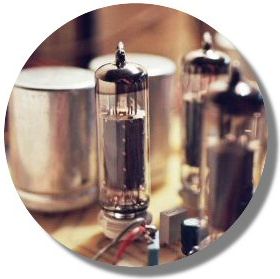
Historical Background of guitar amps
Rock music evolved from Blues, the music of the streets. Most musos’ of the 50s and 60s were poor and guitar amps made to a budget. Some but not all technical principles of amp designs were well thought out.
Fender and Marshall were the dominant and most copied brands. The powerful amps had 4 output valves in parallel push-pull and gave approx 60 – 100Watts.
The Myth
Most amp manufacturers were conservative from a previous generation with a background of country, jazz and religious music. They were horrified by the anti-religious, drug driven, sex crazed rock musos of the 60s’ diving their amps at full power into hard distortion for sustain. When these amps were first designed in the 50s, it was inconceivable they would be used in this way.
The Reaction
Many manufacturers reacted by making warranties void if amps were driven at full power, some threatened to cut off retailers who sold their amps to bands that played ‘music of the devil’.
The parody of this historical contradiction has been rewritten, to fit mythical beliefs that brilliant designers created these amps for what ‘rock musos’ wanted.
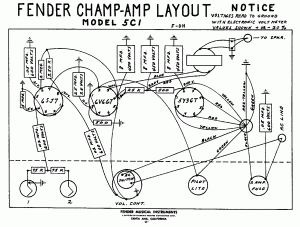
Myths and Legends
Valve technology is intrinsically the most elegant means by which a speaker is able to reproduce music. This is not because valves have magical qualities but because the technology by which they function is not achievable by other means.
In ten thousand years from now Valve amplifiers will possible be the only remaining technology from the 20th century they will be still be being used and loved with as much passion as when first invented. As much as there is no proof that Valve amplifiers can sound superior to solid state I for one if given the choice will only listen to music through Valve amplification.
History
Before solid-state technology, Valve amps were manually assembled by large teams of women in conditions that would not be accepted today. For domestic application the majority were not well made. Before manufacture, designs were scrutinised and modified to reduce production cost. Valve count kept to minimum, cheapest components used at voltage rating limits, safety standards almost non-existent.
The heart of a valve amplifier is the output transformer and accounts for most of the bulk and weight, it is also the most difficult and highest cost item to make. Size and therefore performance was reduced to minimum, especially when used for musical instruments. Only a few brands were made with technical excellence.
By the mid 1960s, valve amp technology started to leap forward, but too late. As sold-state arrived, manufacturers competed to be first to make the change. This new technology reduced size and costs. It enabled production to be mechanised and staff reduced.
The first solid-state amps used germanium transistors, which performed poorly, until silicon arrived.
The intense marketing of solid-state amps caused valve amps to be perceived as worthless, except for musicians.
Virtually mountains of them ended up in the landfills of our expanding cities.
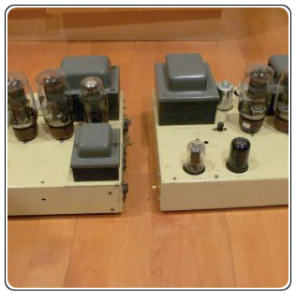
The Basic Principles
A Valve is an extension of the light bulb. Theoretically inside the valve is a vacuum. The hot filament is called ‘Cathode’ (Let’s not forget a T.V. is a’ Cathode ray tube’ ). Around the outside of the Cathode is a cylindrical metal tube called ‘Anode’.
When a +Voltage is placed on the Anode and a -Voltage placed on the Cathode, a large current can flow between them, but not the other way around. This is called a ‘Rectifier’ or diode.
Grid: A fine helix (spiral) wire called ‘Grid’ is placed between the Cathode and Anode. A small variable voltage (music signal) on the Grid varies the large current between the Anode and Cathode. The small varying input signal is now amplified to a large varying current.
The result is very linear. Why this happens is a mystery. The fact that it works and the universe exists is a miracle. It pays to be humble.
Transistors:
(emitter base collector) are complementary to valves (cathode grid anode).
Transistors are related to crystals. Their individual function is non linear and have to be arranged in compound groups to behave as a linear circuit.
Solid-state amps operate at low voltages (10 – 100V).
Valves amps operate at high voltages (200 – 600V).
Speakers operate at approx (0 – 40V).
The Output Transformer converts the high operating voltages of valves to the lower operating voltage of speakers. A transformer has 2 separate coils of wire (primary and secondary) wound around an iron core.
Electricity flowing through wire causes a magnetic field around the wire and visa versa, a changing magnetic field causes electricity to flow through wire.
The varying amplified current of the valve is connected through the first coil of wire (primary) and creates a varying magnetic field.
The varying magnetic field created by the primary coil, causes electricity to be generated in the second coil of wire, which is wound tightly around the first.
Electricity is transferred to the second coil only when the magnetic field is changing, not stationary. The iron core of the transformer keeps the magnetic field contained so little is lost. The transfer is very efficient.
The secondary coil is connected directly to the speaker.
The reduced secondary voltage is adjusted by the ratio of turns between the 2 coils. Eg 1,000 turns on the primary and 100 turns on the secondary would change the voltage 10:1.
Most output transformers have a turn’s ratio of approx 20:1.
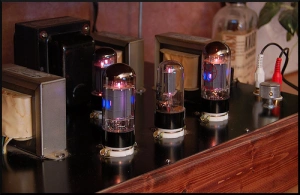
Why do Valve Amplifiers sound different?
When technology changed from valve to solid-state, it was noticed that solid-state amplifiers lacked warmth and bass performance, and had to be twice as powerful as valve amplifiers, to sound as loud.
Current Drive:
Solid-state amplifiers behave in ‘Voltage Drive’. This acts as a short circuit (zero output impedance, or 100% damping factor) across the speakers, causing excessive damping, which reduces efficiency, limiting responsiveness.
Valve amplifiers behave in ‘Current Drive’. This represents an open circuit across the speaker without over damping, allowing maximum response and efficiency.
Sensitivity: Valve amplifiers (current drive) are sensitive to crossover resonances and speaker impedance variations. Quality speaker systems often used passive crossovers that were second-order, constant impedance, and critically aligned to avoid resonant effects. Some quality speakers had copper caped pole pieces, which helped damp impedance variations.
Note:- With solid-state amps in voltage drive, power decreases as the speaker impedance rises. With valve amps in current drive, power increases as the speaker impedance rises.
Therefore a flat speaker impedance is synonymous with a flat frequency response.
Modulating Offset:
The output of solid-state amplifiers is directly connected to 2 DC power supplies through the output transistors. The instantaneous non-symmetry within the music waveform (particularly from the bass notes) is averaged as a modulating DC offset. This modulating offset is small, but it varies the efficiency of the speaker, introducing inter-modulation distortion, amplitude modulating the music.
This problem is mostly eliminated by the trend to use an active sub-bass.
In valve amplifiers the output transformer isolates the speaker from the amplifier electronics. No modulating offset can be produced.
Open Loop Gain: Feedback
Solid-state amplifiers are inherently nonlinear.
They have a very large ‘open loop gain’ approx 20,000. The amplifier output is (feedback) to the comparator input to reduce the gain to approx 50. Therefore 99.9% of this feedback corrects all instability and non-non-linearity of the amplifier, as explained in amplifiers.
The speaker also acts as a large microphone. All non-linear movements and vibrations within the speaker cone, (caused by reflected nodes, chaotic resonances etc) of which there are many, are regenerated back into electricity by the voice coil.
This re-generated signal from the voice coil is inadvertanetly fed-back to the solid-state amps comparator input, and re-amplified back to the speaker as recycled distortion.
Re-amplified Distortion:
This re-amplified distortion is audible by comparison, when switching between a solid-state and valve amplifier in real time. By paying close attention, it is heard as a fine spurious inter-cluttering within the music. This is clearly noticeable with efficient speakers but not with inefficient speakers.
Valve amplifiers are inherently linear.
Their natural gain is small and therefore require minimal or no negative feedback.
Their designs do not require them to have comparator inputs as with solid-state amps. The small amount of negative feedback in valve amps is only required to provide damping to the speaker.
Valve Amplifier Design
From physics we know certain things must be a particular order and size to be efficient and this is acutely so with valve amps.
60Watts is the minimum power capacity for an amplifier to bring quality speakers to life with full fidelity.
The reason:
The dynamic range of music can exceed 60db (power ratio 1:1,000,000).
Transients within the music can exceed 20db (power ratio 1:100).
Therefore amps under 60Watts and ‘Single Ended Class A’ will not be discussed in this text.
Valve amplifiers are used for applications such as guitar amplifiers, satellite transponders such as DirecTV and GPS systems, audiophile stereo amplifiers, military applications (such as target acquisition and radar) and very high power radio and UHF television transmitters.
 Want To Know More? Want To Know More?
Read The Tube Amp Book |
Source:
- Tubeopedia – Wiki of electronic tubes and related topics
- The Vacuum Tube FAQ – Henry Pasternack’s FAQ from rec.audio
- The Audio Circuit – An almost complete list of manufacturers, DIY kits, materials and parts and ‘how they work’ sections on valve amplifiers
- Conversion calculator – distortion factor to distortion attenuation and THD
- AX84.com – Although oriented towards valve guitar amplifiers, AX84’s free schematics and theory document apply well to any tube/valve project
- lenardaudio.com
Our Top 5 Guitar Head Amps
   |
Hayden MoFoThe MoFo by Hayden is an all-valve guitar amp with a whole lot of attitude, and best of all, handmade in England! Unlike other mini guitar amp heads, the MoFo is definitely not a one trick pony. From stunning bell like clean tones with real depth to plexi-esque classic rock crunch, right up to full on metal mayhem, the 30 watt MoFo head does it all. And yes…MoFo does stand for that word. But you’ll have to use one to find out why…it rocks! |
   |
Vox Night TrainNight Train is one sexy beast. Solid enough to inspire confidence, Night Train weighs less than seventeen pounds – and the “armoured lunchbox” dimensions provide extreme portability. Finished with a cool chrome mirror-finish, the signature VOX diamond design reveals that inspiring vacuum tube glow. And of course, the Night Train NT15H includes its own padded carry case to protect your investment. And to make things even more appealing, you get a FREE Vox Wah pedal when you buy Night Train at Dolphin! |
   |
Vox AC4 HeadHere’s another greta Vox product, but an altogether different affair than the Night Train. The Vox AC4 offers pure vintage charm and, at 5 watts, is the quietest head amp of the bunch – as well as the cheapest, at under £200! The AC4 is ideal for recordings, where you crank up the amp to get the best, crunchiest valve tones. This up-to-date Class A version retains the distinctive EL84 power tube of the original and features a 12AX7 powered pre-amp, delivering a classic British tone |
  |
Marshall Haze 15Ever dreamed of owning a all-valve head amp by Marshall, but couldn’t afford one? Your dreams can now become true, thanks to Marshall’s new Haze series, which brings Marshall quality to a more affordable price range. The 15W head is the ultimate in Marshall portable valve tone. On its own you can take it anywhere, safe in the knowledge that you will never have to settle for someone else’s equipment. |
   |
Orange Tiny TerrorSmall, loud and already legendary, the Orange Tiny Terror is without any doubt one of the most popular head amps we sell. Why? This very versatile workhorse won’t let you down in recording sessions or at gigs, and it’s quite affordable, too! The Tiny Terror is ideal for any guitarist seeking professional grade tube tone at a price range that won’t break the bank. With 15 watts of available Class A valve power, the Tiny Terror is a highly versatile workhorse suited to a myriad of guitar playing scenarios. |
Our Top 5 Guitar CabsMarshall MG 4X12B cabinetDue to the technical nature of the Marshall Amplification products advertised on this page it is highly recommended that you contact us by telephone or by coming into our store to discuss your particular requirements and to arrange a demonstration before buying any… VOX V212BNThe VOX AC30 Custom Classic amp is the culmination of over 45 years of guitar amp design and manufacturing. VOX has taken the best AC30 designs and added a number of useful, very cool features to create the most tonally flexible and affordable AC30 to date! Here’s the perfect speaker cabinet for your AC30 head: the V212BN 2 x 12″… Hiwatt 4×12 Fane loaded CabSolid Marine ply construction and loaded with ledgendary Fane speakers. 300 watt power handling 16 ohm impedance. Laney LT212 Lionheart Series Cabinet. 2×12If you have the Laney L20H, you won’t want to compromise that great Class A tone by using any old cabinet. Instead, why not get the matching Laney LT212 cabinet. Featuring 2x 12″ Celestion Heritage G12H Drivers and closed back construction, this cab gives thick, deep tones with growling bottom end power. This stylish and great sounding cab also… Orange PPC212There are many guitarists who are quite happy to plug their head into any cabinet they can lay their hands on. It’s a pity as you only need use your ears to realize the difference the right cabinet can make to your amplifier’s sound. Too many manufacturers compromise their cabinets by using inexpensive speakers. This foolhardy decision can be disastrous!… Our Top 5 Guitar Combos
VOX VT30Sophisticated modeling technology combined with the VOX Valve Reactor power amp circuit that uses a 12AX7 vacuum tube results in sound quality that overwhelms the competition. With sound quality that overpowers its rivals, the VOX Valvetronix VT30… VOX Pathfinder 10The Pathfinder series of VOX amplifiers represents truly outstanding value for money yet captures the very essence and personality of the legend that is VOX. The look and feel of the Pathfinder is inescapably VOX, possessing all of the style of its bigger family members. Small yet perfectly formed, these amps are ideal for practice and recording. Those… Line 6 Spider IV 30The 30-watt Spider IV combo features 12 amp models and seven Smart FX (three effects simultaneously). Each Spider IV preset, amp model and effect exceeds the renowned Line 6 standard of sound quality. Every aspect of the tone, from the guitar input to the three-quarter closed-back cabinet and Celestion® speakers, delivers exceptional definition, clarity and feel. Fender 65 Twin Reverb w/ 2×12 Jenson SpeakersThis amp has seen action in every imaginable musical venue and continues its musical legacy today! Whether you play rock, jazz, country, or whatever, this is what a clean electric guitar sounds like! Or add an upside-down Stratocaster guitar and a fuzz box … Fender’s 85-watt (at 4 ohms) Vintage Reissue of the ?65 Twin Reverb features 4… VOX AC30 CC2The Vox AC-30 is quite possibly the most legendary guitar amp ever made, used by everyone from The Beatles and Rolling Stones to U2 and The Libertines. The AC30 CC2 updates the legendary amp with new and improved features – a guitarist’s dream amp, no less! The new VOX AC30 Custom Classic… Our Top 5 Modeling AmpsLine 6 Spider IV 150 150-watts guitar amplifier combo with FXThe new amplifier line includes many fresh features, innovations and updated highlights from its best-selling and award-winning predecessor, Spider III. This 150-watts model is a great gigging amp full of great sounds and features. Fender G-DEC JuniorBand included—all you need is, well, you! Our G-DEC series models are the world’s only all-in-one amps containing synthesized drum, bass, backing and teaching loops. The G-DEC Junior is a simplified, super-cute version of our award-winning original G-DEC. This 15-watt baby has an 8” speaker and simple interface with knobs for selecting various amp types, effects types, backing… Line 6 Spider IV 30The 30-watt Spider IV combo features 12 amp models and seven Smart FX (three effects simultaneously). Each Spider IV preset, amp model and effect exceeds the renowned Line 6 standard of sound quality. Every aspect of the tone, from the guitar input to the three-quarter closed-back cabinet and Celestion® speakers, delivers exceptional definition, clarity and feel. VOX VT15Sophisticated modeling technology combined with the VOX Valve Reactor power amp circuit that uses a 12AX7 vacuum tube results in sound quality that overwhelms the competition. Randall KH15 Kirk Hammett Practice AmpKirk made it very clear from the start that he wanted to develop a full line of amplifiers that would provide fans his signature tone at any price point. The KH15 is equipped with a Clean, Overdrive and Boost mode and is the perfect practice amp for both the professional and beginning guitarist. … Roland CUBE Street – BlackThe Ultimate Amp for Travelling Musicians If you’re a musician who’s on the move, the new CUBE Street is for you. Whether you’re running to a rehearsal, lesson, street gig, or any situation that requires portability and versatility, the CUBE Street is a battery-powered marvel that’s ready to travel fast. The CUBE Street sounds amazing and is capable. |
A Complete Noel Gallagher (Oasis) Gear Buyers Guide
•October 28, 2009 • 6 CommentsHere’s a new, revised version of one of the most popular posts in our Guitar Blog. If you missed it first time around, now it’s the perfect time to catch up with our complete Noel Gallagher gear guide,

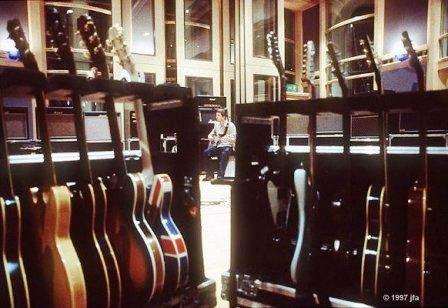
Considering that Oasis are one of the biggest bands ever, and Noel such an influential guitarist, who inspired many kids to pick up a guitar since the band released its debut single “Supersonic”, it’s quite surprising that info about Noel Gallagher’s gear is so sketchy and incomplete – no extensive gear interviews, no clear photographs of his pedalboard, etc…so it was about time we had a good look into what he’s been using over the years!
The job is not made any easier by the fact that Noel is a true “gearhead”. He collects guitars, amps and pedals and it’s quite difficult to find out what he was using at any given time – his setup changed several times, and there might be some pedals listed here, for instance, that he may or may not have used live but maybe just in records.
But, all in all, this guide is definitely (maybe) quite accurate still, so enjoy!
Early Years – 1994:
If you want to have a similar setup to his early, pre- Definitely Maybe days, here’s what we recommend:

Gear tip: the Vintage V100, is as good as the Standard Epiphone Les Paul, and made in the same factory! The Vintage Lemon Drop is probably BETTER than any Epiphone…faithful replica of Peter Green’s guitar. Green is one of Noel Gallagher favorite guitarists.
Pedal-wise, a trademark Noel Gallagher trick is to add delay on some guitar solos. So…get a delay pedal, it’s essential!
Like many skint, up-and-coming musicians who wanted to get some good affordable gear, his main guitar in the early years before the release of “Supersonic” was an Epiphone, the Les Paul Standard model, in cherry Sunburst. It might be the same one you see on the UK version of the “Supersonic” video.
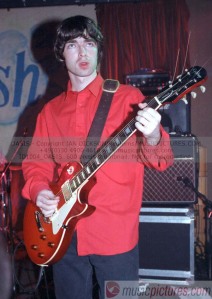 Noel’s early setup – click to enlarge! Noel’s early setup – click to enlarge! |
Ampwise, Noel had a quite interesting setup:
A Roland Space Echo RE-201 into a small Marshall Solid-State Combo and then into a Vox AC-30, as the photograph below, taken in January 1994 shows:
Noel loved, at the time, the crunchy sound of a good Marshall amp distortion, so he plugged it into the clean channel of a Vox AC-30…possibly a late 70s version with no reverb.
The Space Echo was probably used for the reverb and nice compression sound. Though, if he wasn’t using a Boss DD-3 at the time, then maybe the delay sounds you hear in tracks such as “Columbia” are the Space Echo.
In the first Oasis TV appearance, playing “Supersonic” (available on the Definitely Maybe DVD) Noel still had the Space Echo and Marshall, but the Vox AC-30 gave way to the WEM Dominator 25 watt tube Amp.
We have no info whether that setup was used in the studio for the “Definitely Maybe” sessions, but his live sound around this era (and then throughout the ‘Definitely Maybe’ promotional gigs) was great:
Really loud and distorted, a true “wall of noise” that was somewhere between the shoegaze noise Noel must’ve listened to a lot (and which was popular during the early 90’s) and the more classic rock sound he adopted later.
If you want to have a similar setup to his Definitely Maybe tour days, but you’re on a budget, here’s what we recommend:

- Ibanez TS-9 Tubescreamer (classic! For a cheap alternative, try the TS-7 Tubescreamer – very good!)
- Boss DD-3 Delay
 Noel with Les Paul and old WEM amp Noel with Les Paul and old WEM amp |
After Definitely Maybe was released, Noel may have still kept the Epiphone Les Paul for a while, but he quickly moved to Gibson ones:
He could be seen using a Cherry Sunburst Gibson Les Paul (with open coil bridge pickup), and a black Gibson Les Paul Custom (first US tour, December UK gigs) which gained an “Oasis” sticker somewhere along the way.
And, of course, we can’t forget the beautiful late 70’s Epiphone Rivieras, in dark brown/ (really deep) Wine Red.
The late 70’s Epiphone Riviera that Noel and Bonehead used to play are quite different than the other Riviera models made before and since: they have humbuckers and stoptail bridges.
The original 60’s Rivieras (and the ones made up until recently) had frequensator tailpiece and mini-humbuckers. The Epiphone Riviera made in the early 90s are a mix of both: they had proper humbuckers but also the frequensator tailpiece.
Those late Epiphone Rivieras that Noel used are called MIJ (or Matsumoko) Rivieras, made in Japan from around 1978 to 1982.
Other Guitars: on the “Supersonic” single sleeve there are two guitars that Noel may have used in the studio but not live – a Gibson ES-335 (red) and a Rickenbacker Jetglo, either the 330 Jetglo or the 360 model.
Noel Gallagher has always loved Semi-Acoustic guitars, throughout his career, and altough he’s used many other types of guitar, we can safely say semi-acoustics represent the quintessential Oasis sound, thanks to their warm, full-bodied tone.
If you’re on a budget, try the Tanglewood TH502 – unbeatable value for money, truly excellent guitars. Again, they are as good as Epiphones.
Here’s some more pics:
 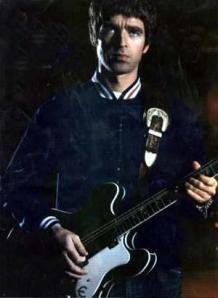 Noel and his Les Paul Custom (left) and Epiphone Riviera Noel and his Les Paul Custom (left) and Epiphone Riviera |
Amps:

His main amp appears to be a Marshall Stack then – Marshall JCM 900 100 watt head w/1960A & 1960B 4×12 cabinets.
FX Pedals:
By the end of 1994/ early 1995 (Live By The Sea DVD) Noel Gallagher’s pedalboard definitely had the following pedals:
- Vox V847 Wah
- Ibanez TS-9 Tubescreamer (classic! For a cheap alternative, try the TS-7 Tubescreamer – very good!)
- Boss DD-3 Delay
Some say he also had a Boss CS-3 Compressor and a Boss SD-2 Dual Overdrive. One of Noel’s favourite tricks was to use lots of delay and scratch his guitar strings with a metal slide…definitely one of the most fun things a guitarist can do onstage!
Some reports suggest that Noel only used the TS-9 for solos, relying on the Marshall distortion.
THE BIG TIME – What’s The Story (Morning Glory) To Knebworth, 1995-1996:
Noel’s setup changed little during this time, still sticking to his favourite guitars, amps and FX pedals from the previous tours. One notable addition to his pedalboard was a classic Boss PH-3 phaser pedal used for some psychedelic swirly sounds during live “jams” such as “I Am The Walrus” on the “There And Then” DVD.
 In a promo photo released during the recording of “Some Might Say”, Noel is seen holding a Gibson Non-Reverse Firebird, awith an Orange stack in the background. In a promo photo released during the recording of “Some Might Say”, Noel is seen holding a Gibson Non-Reverse Firebird, awith an Orange stack in the background. |
According to some sources Noel used 2 Orange Overdrive 120 heads w/2 4×12 cabinets, but a Marshall Stack was still a favourite.
On the credits of “What’s The Story (Morning Glory)” it also says that Noel used an e-bow.
And then there was…MAINE ROAD!
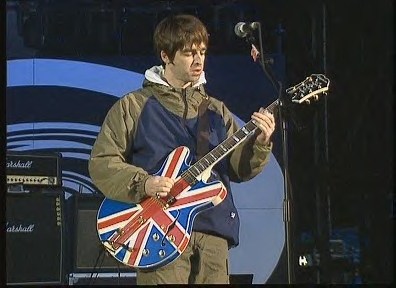 It was at Maine Road that Noel Gallagher debuted his most iconic guitar – the Epiphone Sheraton Union Jack It was at Maine Road that Noel Gallagher debuted his most iconic guitar – the Epiphone Sheraton Union Jack |
Some might say it’s a Epiphone Riviera, but they are wrong…the headstock gives the clue: it’s a 60’s Epiphone Sheraton alright. Unlike the new Sheratons, the 60s version looked very similar to the 60’s (and to the most recent) Riviera, as both featured frequensator tailpiece and mini-humbuckers. It was a present from then girlfriend Meg Matthews, and customized by a London luthier.
Maybe most of you realize this, but some might not: It’s worth noting that Noel Gallagher’s signature guitar, the Epiphone Supernova, is an entirely different thing from the Union Jack guitar he played at Maine Road, and we’ve found no evidence he’s ever played it. He just posed with it. The guitar – excellent as it is, by all accounts – is just an expensive piece of merchandise…and quite different than the original Union Jack guitar: the Supernova has stoptail bridge and humbuckers, as opposed to frequensator and mini-humbuckers, making it closer to the Epiphone Sheraton II or the 70s Epiphone Riviera.
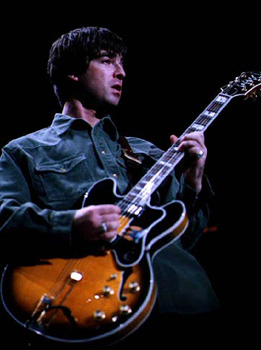 The 60’s Epiphone Sheraton quickly became one of Noel’s favourite guitars, and could be seen at several gigs – not the Union Jack, but a sunburst model The 60’s Epiphone Sheraton quickly became one of Noel’s favourite guitars, and could be seen at several gigs – not the Union Jack, but a sunburst model |
Sadly discontinued, the Epiphone John Lee Hooker Signature Sheraton I (not the commonly found Sheraton II) looked exactly like Noel’s. Some sites say Noel Gallagher played one – he might, but not before 2000, when the guitar was released. So the guitar we see him playing at 1996 gigs – including Knebworth – must be an older model.
FROM THE BE HERE NOW “WILDERNESS YEARS” to FAMILIAR TO MILLIONS (2000):
Where Did It All Go Wrong? After the halcyon days of Knebworth, all of a sudden Oasis were not cool anymore in the eyes of many, despite their still huge popularity, and one of the reasons was “Be Here Now”, the drug-fuelled Britpop opus and nail in its coffin.

But, on a guitar point of view, no one can complain – Noel Gallagher sounded wilder and louder than ever!
He was using some fuzz pedal for the first time, a Coloursound Tone Bender. The Coloursound myspace page lists him as one of the clients. Great pedal, dearly priced. (For cheaper options, the Boss FZ-5 and the Electro-Harmonix Double Muff are great for vintage gritty tones like the Tone Bender)
He still used his Epi Sheraton a lot, but during the “Be Here Now” tour his main guitar seemed to be the Gibson Silver Florentine (Les Paul Semi-Acoustic):
Of course, he famously appeared with a Gibson Flying V on the “Do Y’r Know What I Mean” video, and posed with a Blue Fender Jaguar, but posterity has not registered whether he played them on records or gigs:
AND THEN COMES “Go Let It Out” and “Standing On The Shoulder Of Giants” (2000) and here’s a very accurate list of pedals Noel Gallagher used, in the Jools Holland Oasis special, in 2000 on BBC:
- Vox V847 Wah
- Boss HR-2 Harmoniser
- Ibanez Tubescreamer TS-9
- Boss LS-2 Line Selector
- Sib Echodrive
- Boss RV-3 Digital Delay/Reverb (now discontinued, replaced by the Boss RV-5)
- Way Huge Aqua Puss Delay
- Hughes&Ketner Rotosphere
The Hughes & Kettner pedal is an excellent “Leslie Speaker” simulator, used in tracks such as “Who feels Love?”
Noel Gallagher also began using Rickenbacker guitars…including a white Rickenbacker 330 which used to belong to Paul Weller, and used when The Jam performed “Beat Surrender” on Top Of The Pops! Weller is a good friend of Noel and gave the guitar as a present.
  Rickenbacker 330 (left) and Fender Telecaster (paisley) Rickenbacker 330 (left) and Fender Telecaster (paisley) |
But his main Rickenbacker was a 330 Mapleglo…beautiful guitar…used for “Go Let It Out” and “Who Feels Love”:

FROM 2000 TO NOW – NOEL GALLAGHER’S CURRENT SETUP:

Guitar-wise, Noels current favourite is a Gibson ES-355 with Bigsby, in Cherry. This is NOT an ES-345 as reported in some sites. However…Noel also has a Gibson ES-345! But it’s a non-bigsby model, also in cherry
  Noel and his ES-355 (left) and ES-345. The 345 has no Bigsby and no diamond inlay. Noel and his ES-355 (left) and ES-345. The 345 has no Bigsby and no diamond inlay. |
 Also, another favourite guitar is the Gibson Trini Lopez, as seen on the video for “Lyla”. Also, another favourite guitar is the Gibson Trini Lopez, as seen on the video for “Lyla”. |
Noel also uses the El Dorado guitar straps.
He can also be seen with a Les Paul, as well as the occasional Telecaster. And here’ sa few pics for you:

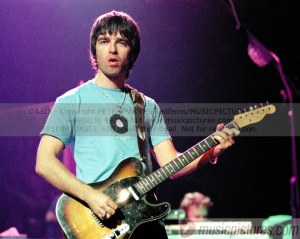
 Above: Fender 60s Telecaster, White…a new one is quite affordable! Above: Fender 60s Telecaster, White…a new one is quite affordable! |
His pedalboard/rack / amps have ballooned so much, it’s quite hard to keep track of what’s his current gear and how it all works! We managed to find info on two similar but different recent setups, which as far as we can see are almost 100% accurate!
One surprising thing is that his main amp now is the little (but great) Fender Blues Junior!
Click on the images to resize:
We can see (almost) clearly that he now uses a Dunlop Crybaby 535Q Wah, still uses an TS-9 Tubescreamer, has a Danelectro Dan-Echo delay, a discontinued Boss PN-2 tremolo/pan, and still used the LS-2, Echodrive and Rotosphere pedals. According to the scheme, the LS-2 is used to bypass a Line 6 rack delay, which can indeed be seen in the pictures.
The other rack-mounted gear include a Korg DTR-1 Tuner (now surpassed by the DTR-1000), TC Electronics 2290 delay, compressor, Furman PL8 Power Supply, signal splitter and noise redction boxes…
His main amp sound are 2 Blues Jrs run through THD Hotplates into Marshall 4x12s (with Celestion G-12’s) There are two heads too: a vintage Vox AC-50 head, and also an Orange head…some mention OTR-120 but could also be a different Orange one. Other amps mentioned as being used by Noel are Clark Beaufort Combo and Clark Tyger Combo, but we found no more details about it, so we’re not sure!
So far so good, but we found more recent (2007) pictures which seem to update the info above a bit!
Huge new Pedalboard, maybe some MIDI controls for the racks as well? Who knows. Between the TS-9 and the Wah there’s a new pedal, dark purple, which fits with the boutique Analogman King Of Tone. According to their website “In spring 2004 Noel Gallagher from Oasis got one and is using it a lot along with his mini bicomp and Boss DD-6 with high cut mod”. We can see that the Dan-Echo is gone and there’s a Boss delay there…so it must be the Boss DD-6 as mentioned by Analog Man!
Like Gem Archer, now Noel uses a Line 6 DL-4 pedal, widely regarded as the best delay available, used by 9 out of 10 rock stars, apparently!
The SIB Echodrive, Boss PN-2 and LS-2 Line Selector remain.
We can’t see them on the photographs, but some sites state that Noel has purcahsed the Crowther Hotcake pedal and the Pete Cornish SS2. The Pete Cornish website states that Noel purchased a custom SS2 fuzz pedal in 2005…
As for his amps…the setup is almost the same…except there’s no Orange head to be seen, just one Blues Junior, a Fender head into a Fender Cab (on top of a Marshall cab). There’s also a Line 6 Pod Pro (now surpassed by the Pod XT Pro model)
 This picture shows the current amp setup of Noel Gallagher (click to resize) This picture shows the current amp setup of Noel Gallagher (click to resize) |
Getting The Noel Gallaghet Current Tone:
Getting a basic Noel-like setup won’t be that expensive, really. Go for a Fender Blues Junior, into a Marshall MG412 cab, which is not as good as the more expensive Marshall cabs, but should do the Job if you want to keep things cheap – this setup would cost just a bit more than a Fender Hot Rod Deluxe, for instance! The Blues Junior is a fantastic little amp, especially when you select the “fat” mode – nice crunchy tube tone…into a cab, it usually sounds amazing.
So do that, and get some of the usual Noel Gallagher pedals…starting with the TS-9 Tubescreamer, of course, and use a semi-acoustic guitar. Way to go!
And, finally, here’s a few more pictures of Oasis and Noel Gallagher’s gear so you can have a nose and se if you can find out anything else!
Click on thumbnails:
NOEL GALLAGHER ACOUSTIC GUITARS:

We decided to leave them for the end. As a typical singer-songwriter, Noel is never far apart from a good acoustic guitar. His favourite is and will always be an Epiphone EJ-200 or, as of late, the Gibson J-200, both sunburst…as you can see in several photos.

List of acoustic Guitars:
-
Gibson J-45 Acoustic
-
Gibson L-200 Acoustic
-
Epiphone Custom EJ-200 Acoustic
-
Epiphone Frontier Acoustic
Apart from Gibson and Epiphone, the only other brand Noel has used quite a bit has been Takamine, who make some really nice guitars…View Takamine

-
Takamine EF-325SRC Acoustic
-
Takamine FD -460SC Acoustic
-
Takamine EG 335 12-string Acoustic
-
Takamine NV360S Acoustic
Also used a Guild 12-String, as shown on “Sad Song” live at Jools Holland (“Definitely Maybe” DVD)
EXCLUSIVE OASIS INSIDER INFO:
A “Guitar Player Blog” reader, Lloyd, got in touch with us, with some first hand info we’d like to share with you. A friend managed to get some really good pics of Noel’s and Gem’s pedalbaords. And here’s what could be seen. Thank you for the info, Lloyd!
“I am having a litlle bit of trouble making a copy of the photographs at the minute, from the images i can see that noel has:
Boss Chromatic tuner, Dunlop Cry Baby Wah, Mr. Echo stomp box (the first one, not the mr. echo plus!), Tubescreamer TS-9, The Boss DD-3 delay pedal…well, he has 3 of them in his current set-up!!! There is a stomp box that was made up by his head roadie and guitar-tech Jason Rhodes for which i have no idea of its purpose, Boss PN-2 Trem/pan, LS-2 Echodrive, There is one more pedal that i dont know what it is, its a grey pedal with a similiar shape to the boss pedals but with a more rounded front. The pictures were taken just after a soundcheck whilst onstage, positioned in-between the two floor monitors is another Echodrive which is not connected up at all, however i have been informed that he does sometimes use them both. There is no sign at all of a line selector however the way the system has been set up neither Noel or Gem actually press the actual pedals there are small rounded chrome buttons each lebelled with the type of effect that it is connected up to, so there may be a line selector especially built in to the system. Gem has: Boss Chromatic tuner, Vox Wah-Wah, Pro-Co Rat Distortion Pedal, Boss Tremolo TR-2, Boss DD-3 delay, Boss RV-3 digital reverb/delay (now Boss RV-5) Boss AC-2 acoustic simulator (now replaced by the Boss AC-3) Line 6 DL4 Delay Modeler, I hope that this email has been a lot of help to you and wish you all the best with your site, if you ever need anymore help or info jus drop us an email.”
The Boss PN-2 Tremolo/ Pan is a classic and quite collectible pedal, also used by people such as Graham Coxon (Blur) and Kevin Shields (My Bloody Valentine). You can still find it on eBay if you’re lucky, or, if you want to save some bucks, you could get the Behringer copy, the TP300 Ultra Tremolo/ Pan. Either way – you’ll need two amps to mak ethe most out of it.
Other Gear:
According to some websites, Noel uses Shure Beta 57A mics for his vocals, Ernie Balls 46-10 strings, and Dunlop .88mm picks.
The most recent studio photograph of Oasis (shot during the recording of “Dig Out Your Soul”) appears to show an old Boss CE-1 Chorus somewhere, too…but we couldn’t see clearly what was most of the gear, apart from the usual Vox Amps (AC50?), Line 6 DL4…
OASIS CANADA 2008 TOUR – GEAR INFO!
New Info! Some pics seem to reveal that Noel is using Hiwatt speaker cabs with his Fender Blues Junior, now!
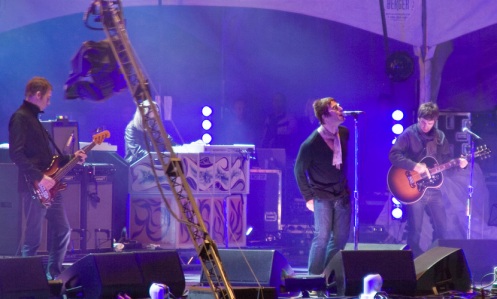 Oasis live, Toronto 2008 Oasis live, Toronto 2008 |
- By the looks of it, he’s using two Hiwatt bass cabs – looks like the Hiwatt Celestion Loaded 4×10″ + 1×15″ Cab. If that’s right – pretty cool choice!
We hope you enjoyed this guide! We’ll keep updating it whenever we find new info.
Click here to see all Oasis/ Noel Gallagher products that can be found at Dolphin!
Read News:
How To Sound Like The Arctic Monkeys – A Complete Gear Guide!
•October 21, 2009 • Leave a Comment
Arguably the biggest rock band in Britain right now, the Arctic Monkeys . Here’s a look at what gear they’ve been using in their gigs.
Firstly, it’s good to point out that their current setup is quite different from the one they used to have when they were touring their first album, “Whatever People Say I Am, That’s What I’m Not”. Back then, they had a much simpler setup:
Singer/ guitarist Alex Turner had two Pro Co Rat 2 pedals, a Boss TU-2 Tuner and that was it. His amp of choice was an Orange AD30. His main guitar was a white Fender Standard Stratocaster. View Alex Turner pedalboard
Lead guitarist Jamie Cook ‘s setup was fairly simple too: A Fender Telecaster 62 reissue. His pedals were a MXR M-104 Distortion+ , a Electro-Harmonix Big Muff and, at least for a while, he could be seen using a T-Rex Dr. Swamp twin distortion pedal. View Jamie Cook pedalboard.
He also had a Boss TU-2 Tuner. Apparently, according to many different sources, his amp back then was a Hiwatt Custom 50-Watt 2×12 Combo
Both of them have always used a Dunlop DC Brick Power Supply.
Favourite Worst Nightmare gear
The second Arctic Monkeys album sounds much more varied than their first one, and, indeed, it is reflected on their choice of pedals. Both guitarists use more FX onstage now.
from left: Alex pedals, Jamie’s pedalboard (click to enlarge)
Alex: His setup is entirely different now. In a few gigs this year he was still using the two Pro Co Rat 2, but it didn’t look as if he was using them at their recent Old Trafford gig. Instead, he was using an Ibanez Ts-808 Tubescreamer, one of the most classic overdrive pedals out there, used by everyone from Noel Gallagher to Stevie Ray Vaughn.
His other pedals are:
- Hughes & Kettner Tube Rotosphere, a preamp pedal that simulates the sounds of a Leslie speaker. Great stuff, also used by Franz Ferdinand, Oasis and others.
- Danelectro Reel Echo
- Electro-Harmonix Deluxe Memory Man
It appears that Alex also uses a Boss LS-2 Line Selector. He’s been using a Vox AC-30, as well. His main guitar now is the rare, discontinued Fender Bronco, very similar to the Fender Mustang, the main difference being that the Bronco, originally a starter guitar, has only one pickup.

above: Arctic Monkeys and their Vox AC-30 amps
Jamie: The lead Arctic Monkeys guitarist has quite a elaborate pedalboard now. Apart from the ever-reliable MXR Distortion pedal, his setup has completely changed. It seems, looking at recent photographs, that he uses a Little Big Muff now…maybe because it’s smaller and he has too many pedals now? Who knows…the Dr Swamp is nowhere to be seem, and instead he has:
- one Electro-Harmonix HOG, a polyphonic guitar synthesizer pedal.
- two Electro-Harmonix Deluxe Memory Man
- one Electro-Harmonix Pulsar tremolo pedal.
Jamie also uses a Boss LS-2 Line Selector, some sort of Wah/ Volume pedal and, according to some, a phaser pedal as well (which sits between the Big Muff and LS-2, but is not clear on any photograph we’ve seen). View Jamie’s new pedalboard.

Jamie Cook’s main guitar now is an old Gibson ES semi-acoustic model. Amp-wise, he still sticks to Hiwatts.
If you want to get an “Arctic Monkeys sound” but don’t want to break the bank there are some quite good alternatives: A cheap Orange Crush 30 or Vox AD30 VT can get you all the crunchy tones you need. Squier Strats and Teles or an Epiphone semi-acoustic can do a good job and offer a good, affordable alternative, too. Dolphin Music has even a Arctic Monkey Bundle…worth a look!
Guitars
– Fender Jazzmaster
– Fender Arctic White American standard Stratocaster (maple fretboard)
– Black Mexican standard Fender Stratocaster guitar (maple fretboard)
– black Fender Bronco with a black pickguard and rosewood fretboard
– Gretsch Spectra Sonic
– Ovation Viper
Amps and Cabinets
– Orange AD30T amplifiers (used in the past)
– Fender Vibroverb for clean tones
– Selmer Zodiac 30 watt for more distorted tones
Effects and More
– Pro Co Rat 2 distortion pedals

– Ibanez TS-808 Vintage Tubescreamer overdrive pedal

– Hughes & Kettner Rotosphere MK2

– Electro-Harmonix Deluxe Memory Man

– Dunlop DC Brick Power Supply

– Dunlop Univibe
The Beatles Effects Pedals Guide
•October 21, 2009 • 2 CommentsThe Beatles were musical pioneers, so it’s no surprise that when artists started to use FX pedals, the Beatles were also on top of this trend. Here’s a look at some of the pedals the Beatles have used…and what similar gear you can get to achieve similar tones!

One of the first FX pedals invented was the fuzz…which is not to be mistaken with overdrive or distortion. It’s much harsher! Though, at low volumes (as it was probably most used by the Beatles to start with) it can add a little extra “kick” on your solos without distorting too much.
One of the first fuzzboxes invented was the Maestro Fuzztone, and the Beatles have used it. It can be seen on some photographs that seem to be dated from the 1063-1964 days:
Beatles and Maestro Fuzztone (click to enlarge)
   Photographs showing the Beatles and the Maestro Fuzztone Photographs showing the Beatles and the Maestro Fuzztone |
Another fuzz pedal the Beatles have used was an WEM Pep Rush, reportedly used on the Paperback Writer recordings. The photograph below, taken around that same era, shows Lennon fiddling with the Pep Rush fuzz pedal:
 Lennon and a Pep Rush fuzz Lennon and a Pep Rush fuzz |
It’s important to note that even though there’s photographic evidence of the Beatles using fuzz pedals from as early as 63/ 64, it doesn’t mean they used them live.
Other fuzz pedals the Beatles are said to have used include the Vox Tonebender, and a Fuzz Face, during the later, Let It Be era. All those pedals are very basic, harsh effects with no tone control. If you want to get a “Beatles fuzz” then, you should get something similar…like the aforementioned Fuzz Face, or maybe the Electro-Harmonix Double Muff, which is very basic and raw – perfect for vintage tones! Though the new Boss FZ-5, thanks to its COSM technology, is said to nail vintage fuzz tones (like…the Fuzztone!) pretty well.
 Beatles with a Vox Tonebender – sitting bottom right, on top of amp head Beatles with a Vox Tonebender – sitting bottom right, on top of amp head |
The Beatles also used Vox Conqueror amps which at the time had in-built fuzz, and this may be the sound you hear in some Sgt. Pepper recordings.
The most basic FX pedal the Beatles have used, was a volume pedal. It was famously used in their b-side “Yes It Is” Apparently, according to legend, George Harrison wasn’t quite able to play his guitar part and use the volume pedal at the same time, so John Lennon was controlling it instead, with his hand! If you want a volume pedal, you can get some pretty good ones now, such as the Dunlop Hi-Gain Volume or the vintage-style Fender Volume pedal.
For one of the Beatles’ loudest records, the ‘Revolution’ version found as the b-side of ‘Hey Jude’, no FX pedals were used – to achieve the piercing fuzz sound, John Lennon’s guitar was plugged directly into the mixing desk, with the channel’s gain right up. They did this in order to get a really distorted sound but avoiding unwanted feedback.
Those were pretty much the only fx pedals the Beatles used for most of their career…but in 1969, during the Let It Be sessions, George Harrison started to experiment with more sounds, and besides the Fuzz Face, he also used a Wah Wah pedal. A Vox Wah or a Dunlop Cry Baby will be perfect for any fans of Let I Be-era Harrison. However, if you want vintage Wah authenticity, the best options are the Dunlop Jimi Hendrix Signature Wah or the Dunlop Classic Wah-Wah with Fasel, which are even more faithful to the sixties sound.
Another effect George Harrison explored in those final days of the Beatles, was the Leslie Rotating Speaker. Of course, Leslie cabs are incredibly rare and expensive now, but some really good pedals replicate that sound. Try the Hughes & Kettner Tube Rotosphere (by far the best one), or the Boss RT-20 Rotary Ensemble. They don’t come cheap…so the best introduction to Leslie sounds is probably the Behringer RM600 Rotary Machine, which sounds really good, too.
Choosing your Electric Guitar: A Buyers Guide
•October 21, 2009 • 3 Comments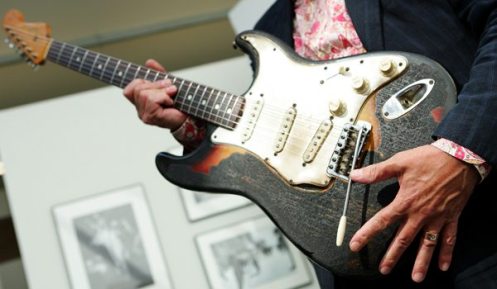
Here is a quick guide we have put together to help you choose your style of electric guitar.
Choose your Body Style…
The Gibson Les Paul shape is among the most recognized solid-body electric guitar designs. It was developed in the early 1950s and has become one of the most enduring and popular musical instrument models in the world. Its design has been left virtually untouched for nearly 50 years. http://en.wikipedia.org/wiki/Gibson_Les_Paul
In mid 1960, the Gibson Guitar Corporation felt that the Les Paul signature model, introduced in 1952, had run its course, and decided to change the design. This new design, with a slim double-cutaway body featuring prominent scarfing around the edges and cutaways, was officially issued in the 1961 model year as a Les Paul signature model. The main idea was to compete with the double cutaway Fender Stratocaster, which gave players easy access to the higher frets. http://en.wikipedia.org/wiki/Gibson_sg
The Stratocaster, often called the ‘Strat’, is a model of electric guitar designed by Leo Fender in the early 1950s. Much of the popularity of the Stratocaster can be attributed to its versatility. The neck, middle, and bridge (in the original manual, labelled “rhythm”, “normal tone”, and “lead”, respectively) pickups provide a wide range of tones. The standard single-coil pickups often found in Stratocasters produce a trebly sound with a high top end and bell-like harmonics.
The Fender Telecaster (aka ‘Tele’) is a dual-pickup, solid-body electric guitar made by Fender. Its simple, yet effective design and revolutionary sound broke ground and set trends in the fields of electric guitar manufacture and popular music. http://en.wikipedia.org/wiki/Fender_Telecaster
Choose your Pick Ups…
A single coil is a type of pickup for the electric guitar. As its name indicates, it is composed of copper wire wrapped in a single coil around a single bar magnet or several rod magnets. Single-coil pickups are most commonly associated with Fender guitars. http://en.wikipedia.org/wiki/Single_coil
A humbucker is a type of electric guitar pickup that uses two coils. Humbuckers have increased output, and because the two coils are of reversed polarity and reverse-wound, noise and interference is essentially ‘canceled out’. http://en.wikipedia.org/wiki/Humbucker
More Info
Choose your Bridge System…
 Stock Tremolo
Stock Tremolo
A tremolo arm, tremolo bar, vibrato bar or whammy bar is a lever attached to the bridge and/or the tailpiece of an electric guitar or archtop guitar to enable the player to quickly vary the tension and sometimes the length of the strings temporarily, changing the pitch to create a vibrato, portamento or pitch bend effect.
Double Locking
 The Floyd Rose Double Locking system consists of:
The Floyd Rose Double Locking system consists of:
- a lock at nut of the guitar, which prevents the tuning (“machine”) heads from being used and holds the strings taut,
- a “floating bridge”, where the other ends of the strings are also vise-locked (hence, “double-locking”).
The locking system helps to keep the strings in tune while the strings are slackened to a degree which wasn’t possible with older tremolo systems, such as those found on Fender Stratocaster, allowing “dive bombs” (i.e. rapid lowering of the pitch of a note). Since the tuning heads are ineffectual with the lock in place, the Floyd Rose bridge has heads for fine tuning; the guitar is tuned before the lock is put on, then fine tuned afterwards. http://en.wikipedia.org/wiki/Floyd_Rose
 Hard Tail
Hard Tail
Instruments without a Stock tremolo or Double locking bridge system are called hard-tail.
Choose your fret board…
From maple to Rosewood there is no one “best” wood. The choice you make should be based upon your application and personal taste or preference.
Chose your neck joint…
This is the point at which the neck is either bolted or glued to the body of the guitar.
 Bolt on Neck
Bolt on Neck
This method is used frequently on solid body electric guitars and is considered the easiest neck joint method. Body and neck cross in horizontal plane and are joined using 4 (rarely 6) screws. As screws damage the wood and could put extra stress on it, typically a rectangular metal plate or a pair of metal plates are used to secure the joint and re-distribute the screw pressure evenly. http://en.wikipedia.org/wiki/Bolt-on_neck
 Glue in Necks
Glue in Necks
Set-in neck is a method of guitar (or similar stringed instrument) construction that involves joining guitar neck and body, pressing it tightly together using some sort of adhesive. This yields better connection of neck and body and makes sound waves. Gibson leads the trend for set-in necks with Gibson Les Paul series, opposing Fender that build guitars traditionally with bolt-on necks. http://en.wikipedia.org/wiki/Set-in_neck
 Through Necks
Through Necks
These are designed so that everything from the machine heads down to the bridge are located on the same piece of wood. The sides (also known as wings) of the guitar are then glued to this central piece. Some luthiers prefer this method of construction as it is said to allow better sustain of each note. Some very high-end instruments may not have a neck joint at all, having the neck and sides built as one piece and the body built around it. http://en.wikipedia.org/wiki/Neck-thru











.jpg)

.jpg)























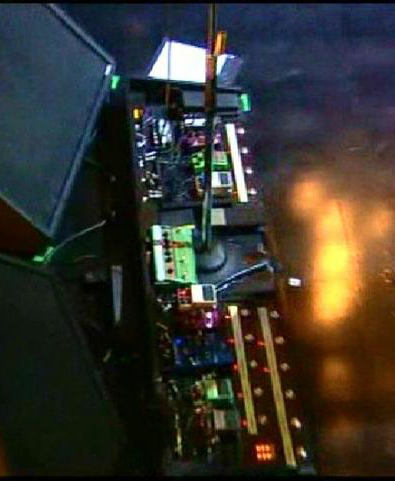



















 Les Paul Shape
Les Paul Shape SG Style
SG Style Stratocaster
Stratocaster Telecaster
Telecaster
 The Humbucker Pick Up
The Humbucker Pick Up